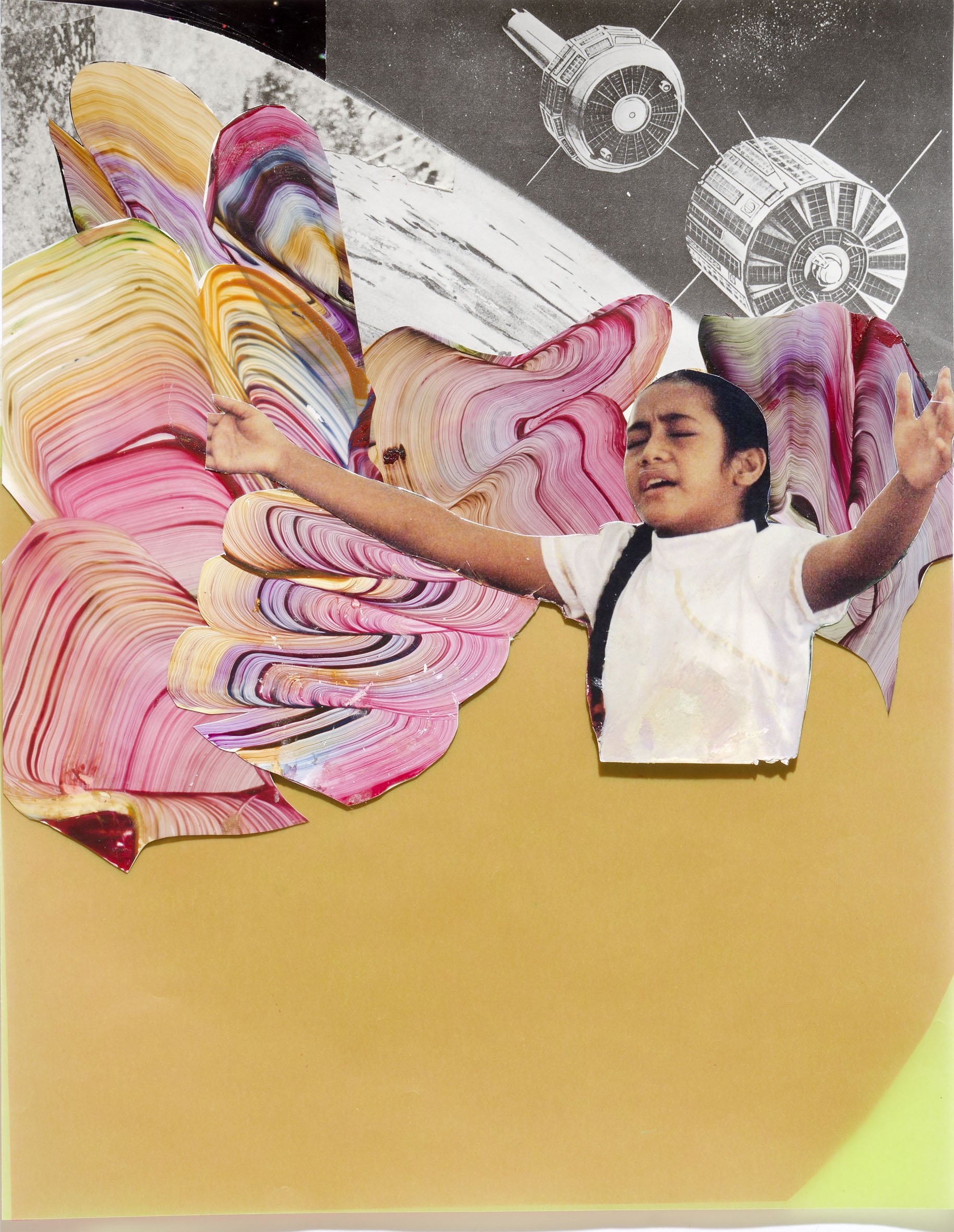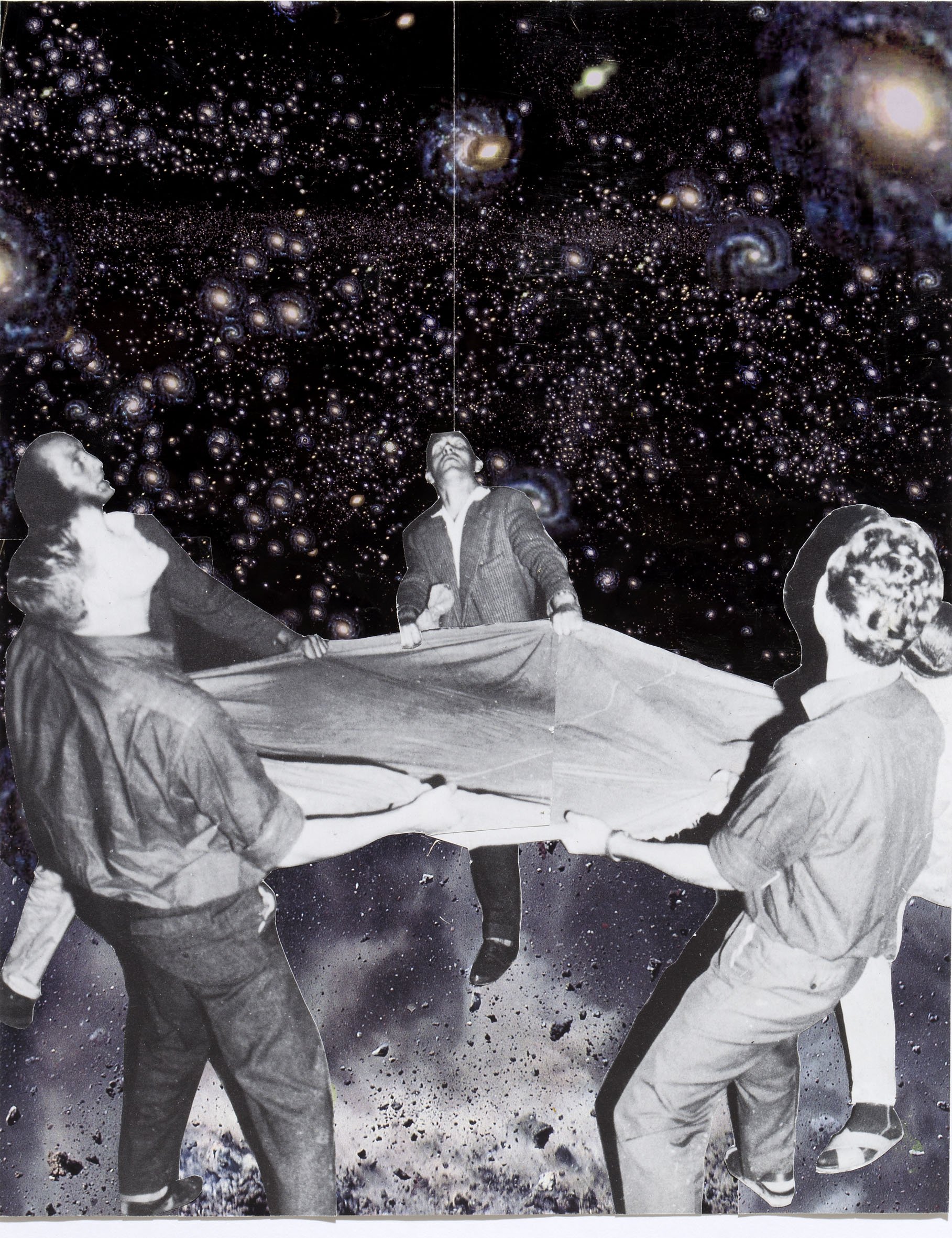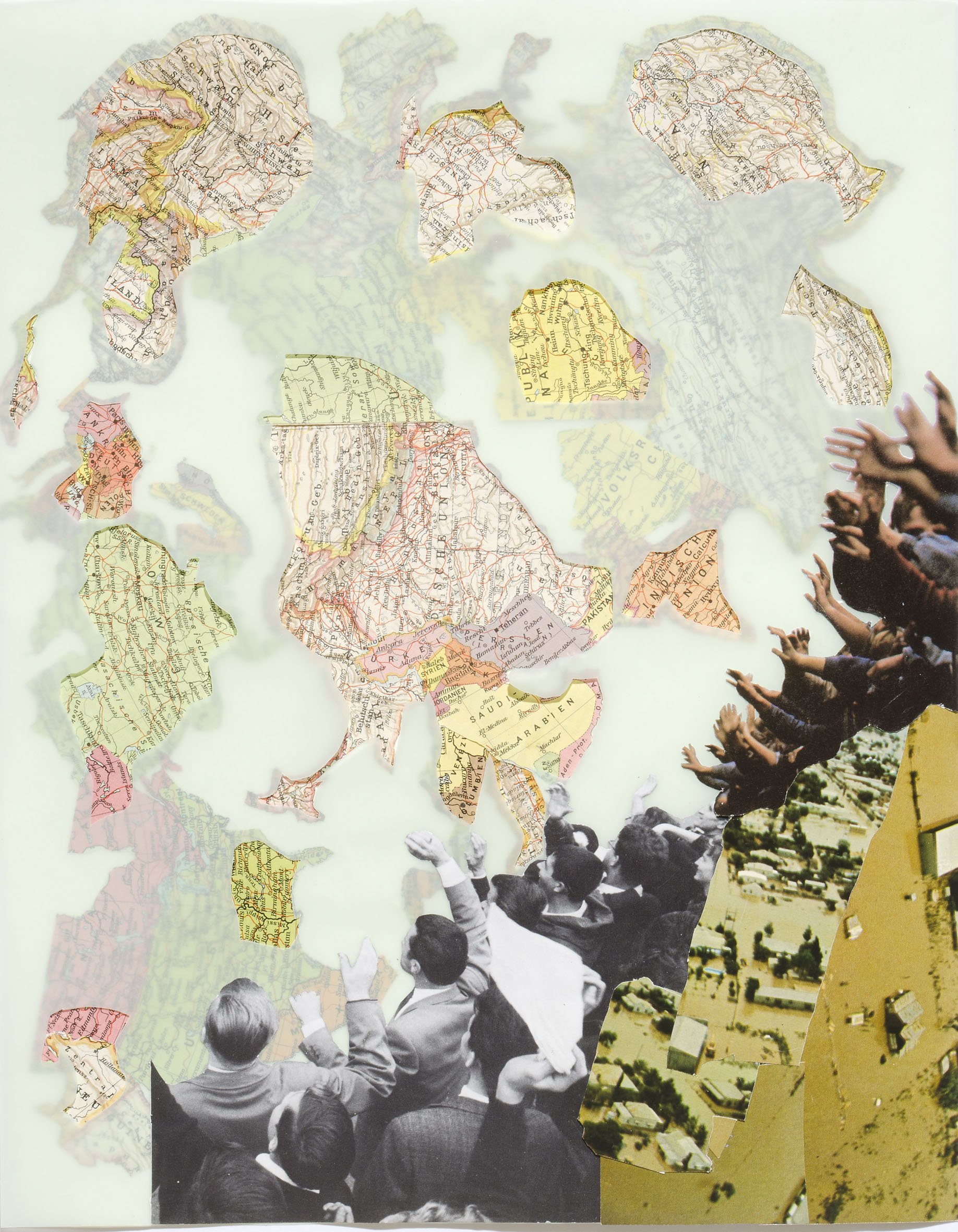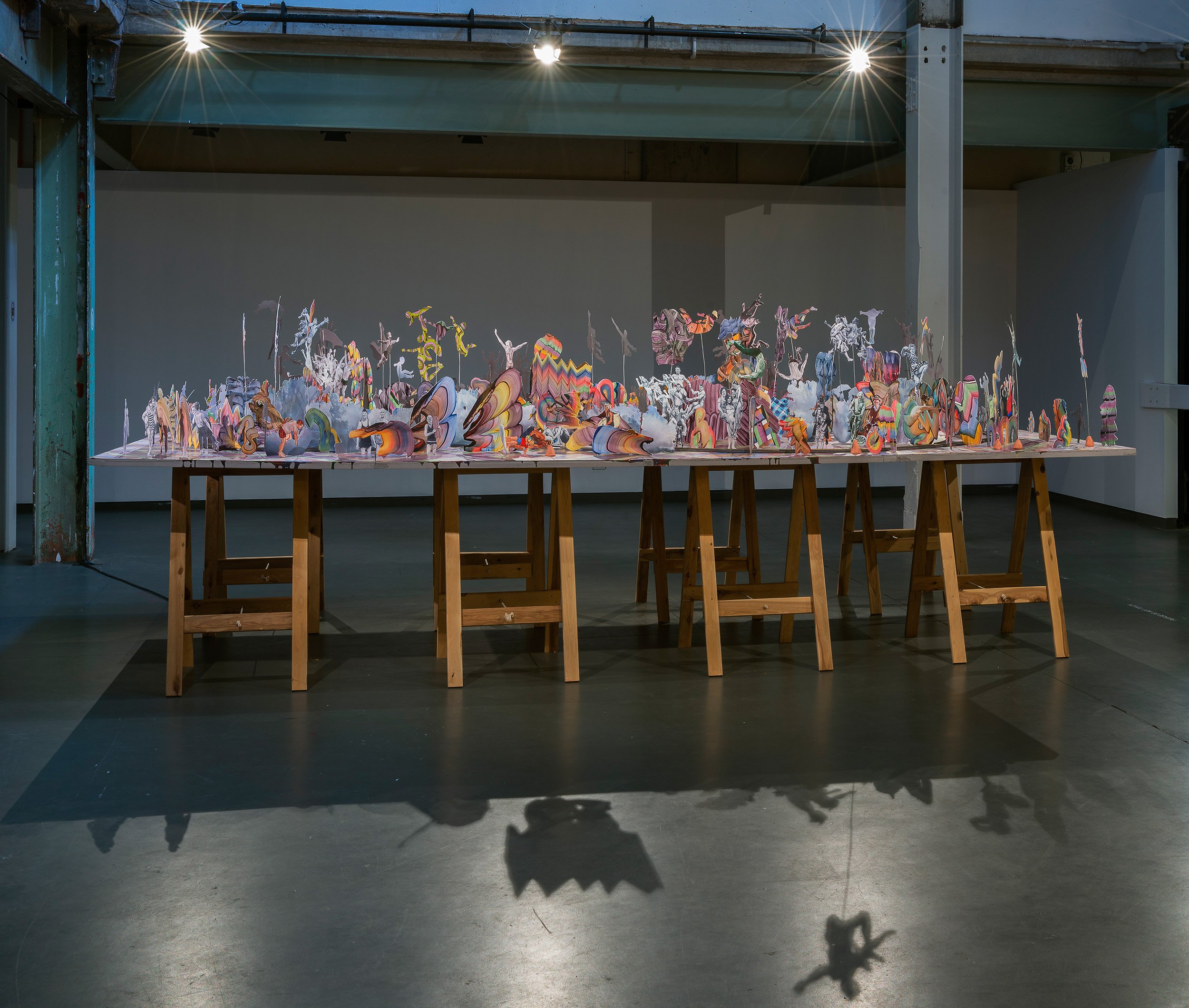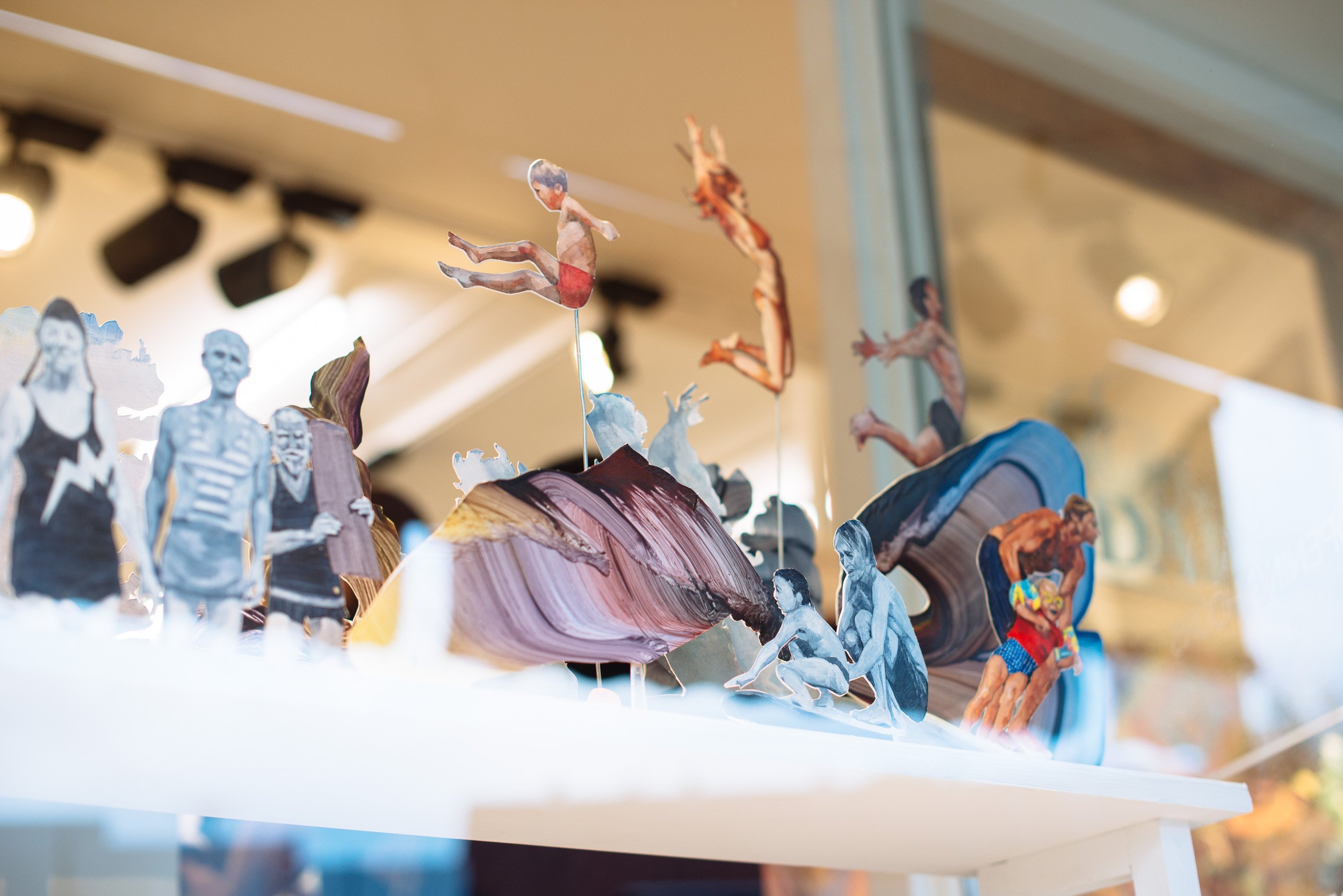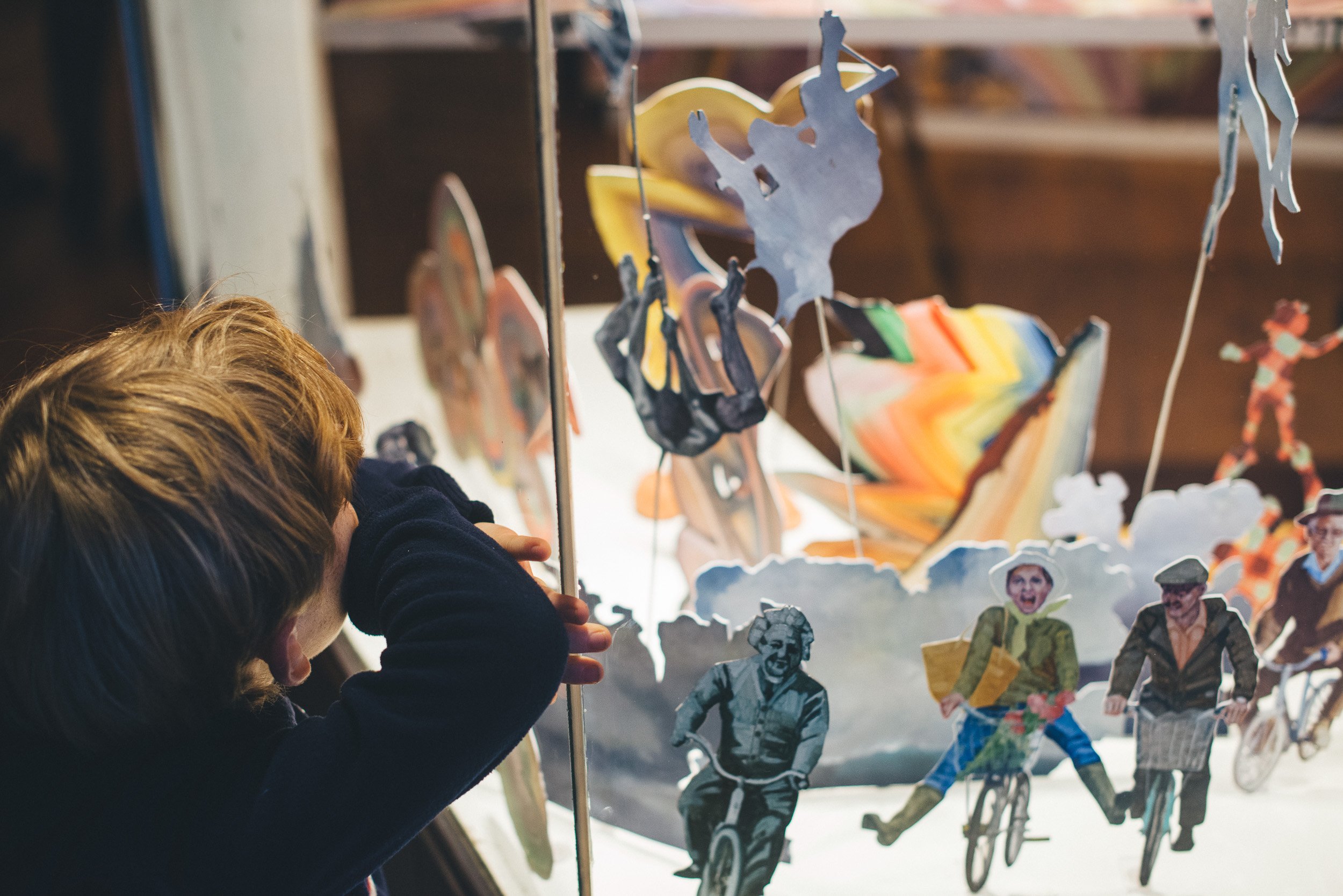Introduction, 2013, Clare Thackway and Gregory Hodge, acrylic and oil on canvas, 183 x 137 cm, Finalist in the Blake Prize 2013
Collaboration with Gregory Hodge 2011-2015
-
Art occupies the role of mediator between man and nature. The original is too great and sublime for the majority to be able to grasp it. But the copy is the product of human hands and so lies closer to our human frailty. The artist should not only paint what he sees before him, but also what he sees within him. If he does not see anything within him, he should give up painting what he sees before him.
- Caspar David Friedrich, 1830
The Romantic artists believed that the direct and mathematical transcription of nature in painting failed to faithfully portray the true magnificence of God’s creation. Rather, the unpresentable nature of God was preserved by paintings tempered by the imperfections of the artist. Friedrich’s paintings of wanderers dwarfed by solemn, moonlit landscapes exemplify this preference for a sublime aesthetic. According to Kant, the sublime sentiment is a deeply equivocal emotion comprising both pleasure and pain. The intersection of these feelings results from a clash between reason and imagination, where the imagination fails to present an object to match a concept. For instance, although I may logically understand that a mountain is finite, its overwhelming presence and my inability to perceive it all at once make it seem infinite, thus any representation I offer (in an attempt to reduce the experience to image or text) will appear awkward and inadequate. The Romantic sublime was thus expressed as a frail and diminished human presence in the world, consistent with the incommensurability of spiritual experience with the artist’s capacity to present it.
There is a feeling of this Romantic sublime in the work of Thackway and Hodge. Like Friedrich, their paintings contain figures frozen by their confrontation with an extraordinary constellation of events: urban miracles, environmental disasters, and cosmic dissolution. But the sublime in this series is subverted; the unpresentable is not attributed to the omnipotence of God and the hope for reunification after death. Despite the documentary nature of their found material, the unpresentable here points to the poverty of human knowledge. Each painting is a unique and inexplicable moment of contact, an unspecified event where something will (might) take place. The success of the project is in part the result of the common theme of introduction/contact, which cuts across both the artists’ practice and their chosen subject matter. In fact, the series is a meditation on the nature of encounter: between artist and artist (in collaboration); artist and spectator; modes of representation (abstract and figurative painting); and subject matter (figures in apocalyptic scenes).
This is the couple’s first collaborative project. Although Thackway and Hodge are both painters, their work could not be more different. Thackway is known for her portraiture and her painterly, figurative narratives. Hodge is known for his vivid, kaleidoscopic abstractions on paper and canvas. The disparity of the artists’ approach is deliberately preserved in their process. Rather than collaborating on a sketch to be used for a final composition, a small collage forms the model. The collage is composed of found newspaper, staged photography and magazine clippings (the figurative element), which are then combined with cuttings of Hodge’s paintings (the abstract element). These collaborative collages pay homage to the anti-bourgeois realism of the early twentieth century Cubists, Constructivists and Surrealists. Picasso and Braque challenged medium specificity by allowing the detritus of everyday life to intervene in their artworks, and the Surrealists undermined the cult of the individual with their cadavre exquis: collaborative assemblages made with an array of materials and techniques.
Although the large-scale canvases in this exhibition restore the unity of the painted surface, the cut-and-paste quality of the collaged prototype remains. Thackway reconstitutes the found ephemera into a painted narrative, while Hodge’s interventions (luminous concertinas of colour) are clearly delineated from the more figurative aspects. In this respect, their collaboration cannot be adequately described as a doubling or unification, because there is no repudiation of self or reconciliation of content/style evident. Alternatively, the introduction of the two artists’ polarity is preserved as if to anticipate coalescence, eruption, or fragmentation. Just as the raised surfaces between their paints refuse to merge, so the moment of contact that threatens to engulf the represented figures is forever suspended.
The same is true for the encounter of the spectator. We are enticed into the same sublime moment of contact as the painted figures that anticipate our presence. The Introduction paintings are intentionally overwhelming in scale, they are consuming and visually seductive, combining a euphoric, carnivalesque spectacle with the ominous undertones of impending catastrophe. This sublime dialectic is described by Burke as terror on the one hand, wherein objects and sensations are imbued with a threat to self-preservation (shadows, solitude, silence and the proximity of death), and on the other delight, which surfaces when the threat of pain abates. This is the paradox of human tragedy and horror: we are compelled again and again to look directly at what might ultimately destroy us. Like Andy Warhol’s relentless reproduction of morbid newspaper tragedies in the death and disaster series (1962-1963), Thackway and Hodge’s paintings highlight the persistence of voyeurism. But this perversity is not without a cost, as Nietzsche reminds us, “When you gaze long into an abyss the abyss also gazes into you.”
If the Romantic sublime is an inadequate characterisation of Thackway and Hodge’s work, perhaps it is because their type of sublime aesthetic is one consistent with contemporary experience. In The Postmodern Condition, Jean-François Lyotard resists the linear, progressive model of history by suggesting that postmodernism is not modernism at its end but in the nascent state, and that this state is constant. The underlying differences between modernism and postmodernism materialise in their unique sublime aesthetics. According to Lyotard, the sublime aesthetic of the modern avant-gardes was a nostalgic one. It allowed the “unpresentable to be put forward only as the missing contents; but the form, because of its recognizable consistency, continued to offer to the reader or viewer matter for solace and pleasure.” In this sense, modern art implied with these “missing contents” the presence of a whole, and the potential fulfilment of the enlightenment project of knowledge and truth.
The postmodern sublime “puts forward the unpresentable in presentation itself,” it is that which “denies itself the solace of good forms, the consensus of a taste which would make it possible to share collectively the nostalgia for the unattainable; that which searches for new presentations, not in order to enjoy them but in order to impart a stronger sense of the unpresentable.” The postmodern sublime is thus an aesthetic the reveals the limits of figuration. It is without rules or consistency, where difference is preserved and meaning is infinitely delayed. Andreas Gursky is frequently cited as displaying these qualities of the postmodern sublime; his photograph of seemingly infinite commodities in 99 Cent (1999) is a formidable sight, transforming the contemporary banal into an apocalyptic scene of rampant materialism. In Gursky’s wondrous/terrible photograph of ordered infinity, the unpresentable and simulacral character of capitalist consumerism is found.
While Thackway and Hodge’s sublime aesthetic is certainly postmodern in sentiment, we must still account for the persistence of nature, the stuff of nineteenth century Romanticism. Nature here is something else. It is captivating, majestic and still capable of swallowing man whole (one only has to recall Turner’s magnificent squalls and infernos), but it is deprived of the intrinsic wrath of God. True to the postmodern sublime, there is no totalising framework to explain these unfolding events; the abyss of the universe escapes reason and appears darker, more labyrinthine and unfathomable than ever. Friedrich wrote “man is the most sublime product of the whole of creation, but also the disfiguring stain in the created world.” Whether we are the sublime product of “creation” is not the point because Thackway and Hodge are interested in the stain. Marvellous (The Producers) or abhorrent (Undertow), the stain of human excess materialises in Introduction as a sublime disfiguration of the earth.
Jaime Tsai, 2013
1. Caspar David Friedrich, ‘Observations on Viewing a Collection of Paintings Largely by Living or Recently Deceased Artists,’ in Art in Theory: 1815-1900, eds. Charles Harrison and Paul Wood with Jason Gaiger (Oxford: Blackwell, 1998): 48-54
2. Jean-François Lyotard, ‘Newman: the Instant,’ in The Lyotard Reader and Guide, eds. Keith Crome and James Williams, (Edinburgh: Edinburgh University Press, 2006) 335
3. Friedrich Nietzsche, ‘Beyond Good and Evil,’ in Basic Writings of Nietzsche, intro. Peter Gay, trans. and ed. Walter Kaufmann, (New York: Modern Library Edition, 2000) 279, Aphorism 146
4. Jean-François Lyotard, The Postmodern Condition: a Report on Knowledge, trans. Geoff Bennington and Brian Massumi, (Manchester: Manchester University Press, 2004) 81
5. Ibid., 81
6. Friedrich, ‘Observations on Viewing a Collection of Paintings Largely by Living or Recently Deceased Artists,’ 48-54
Introduction, solo exhibition at Basso Projects, Berlin, Germany, 2011
An Infinite Everything, Mind the Gap group exhibition at Casula Powerhouse Arts Centre, Sydney, Australia, 2014 and a solo exhibition at the Egg and Dart Gallery, Thirroul, Australia, 2015
Introduction, solo exhibition at Firstdraft Gallery, Sydney, Australia, 2013
Introduction, 2013, Clare Thackway and Gregory Hodge, acrylic and oil on canvas, 183 x 137 cm, Finalist in the Blake Prize 2013
Falling, 2013, Clare Thackway and Gregory Hodge, acrylic and oil on canvas, 183 x 137 cm
Ocean, 2013, Clare Thackway and Gregory Hodge, acrylic and oil on canvas, 183 x 137 cm
Toi Toi Toi, 2013, Clare Thackway and Gregory Hodge, acrylic and oil on canvas, 183 x 137 cm
Undertow, 2013, Clare Thackway and Gregory Hodge, acrylic and oil on canvas, 183 x 137 cm
Weft, 2013, Clare Thackway and Gregory Hodge, acrylic and oil on canvas, 183 x 137 cm, Finalist in the Doug Moran Portrait Prize 2013
Introduction, solo exhibition at Basso Projects, Berlin, Germany, 2011
Untitled 2011, paper collage, 21cm x 29.7cm
Untitled 2011, paper collage, 21cm x 29.7cm
Untitled 2011, paper collage, 21cm x 29.7cm
Untitled 2011, paper collage, 21cm x 29.7cm
Untitled 2011, paper collage, 21cm x 29.7cm
Untitled 2011, paper collage, 21cm x 29.7cm
Untitled 2011, paper collage, 21cm x 29.7cm
Untitled 2011, paper collage, 21cm x 29.7cm
Untitled 2011, paper collage, 21cm x 29.7cm
Untitled 2011, paper collage, 21cm x 29.7cm
Untitled 2011, paper collage, 21cm x 29.7cm
Untitled 2011, paper collage, 21cm x 29.7cm
Untitled 2011, paper collage, 21cm x 29.7cm
Untitled 2011, paper collage, 21cm x 29.7cm
Untitled 2011, paper collage, 21cm x 29.7cm
An Infinite Everything, Mind the Gap group exhibition at Casula Powerhouse Arts Centre, Sydney, Australia, 2014 and a solo exhibition at the Egg and Dart Gallery, Thirroul, Australia, 2015
An Infinite Everything, 2014, acrylic and oil on paper and wood, model train set, clay, wire, rope and perspex, 160cm x 480cm x 210cm
An Infinite Everything, 2014, acrylic and oil on paper and wood, model train set, clay, wire, rope and perspex, 160cm x 480cm x 210cm
An Infinite Everything, 2014, acrylic and oil on paper and wood, model train set, clay, wire, rope and perspex, 160cm x 480cm x 210cm
An Infinite Everything, 2014, acrylic and oil on paper and wood, model train set, clay, wire, rope and perspex, 160cm x 480cm x 210cm
An Infinite Everything, 2014, acrylic and oil on paper and wood, model train set, clay, wire, rope and perspex, 160cm x 480cm x 210cm
An Infinite Everything, 2014, acrylic and oil on paper and wood, model train set, clay, wire, rope and perspex, 160cm x 480cm x 210cm
An Infinite Everything, 2014, acrylic and oil on paper and wood, model train set, clay, wire, rope and perspex, 160cm x 480cm x 210cm
An Infinite Everything, 2014, acrylic and oil on paper and wood, model train set, clay, wire, rope and perspex, 160cm x 480cm x 210cm
An Infinite Everything, 2014, acrylic and oil on paper and wood, model train set, clay, wire, rope and perspex, 160cm x 480cm x 210cm
An Infinite Everything, 2014, acrylic and oil on paper and wood, model train set, clay, wire, rope and perspex, 160cm x 480cm x 210cm
An Infinite Everything, 2014, acrylic and oil on paper and wood, model train set, clay, wire, rope and perspex, 160cm x 480cm x 210cm
An Infinite Everything, 2014, acrylic and oil on paper and wood, model train set, clay, wire, rope and perspex, 160cm x 480cm x 210cm
An Infinite Everything, 2014, acrylic and oil on paper and wood, model train set, clay, wire, rope and perspex, 160cm x 480cm x 210cm
An Infinite Everything, 2014, acrylic and oil on paper and wood, model train set, clay, wire, rope and perspex, 160cm x 480cm x 210cm








